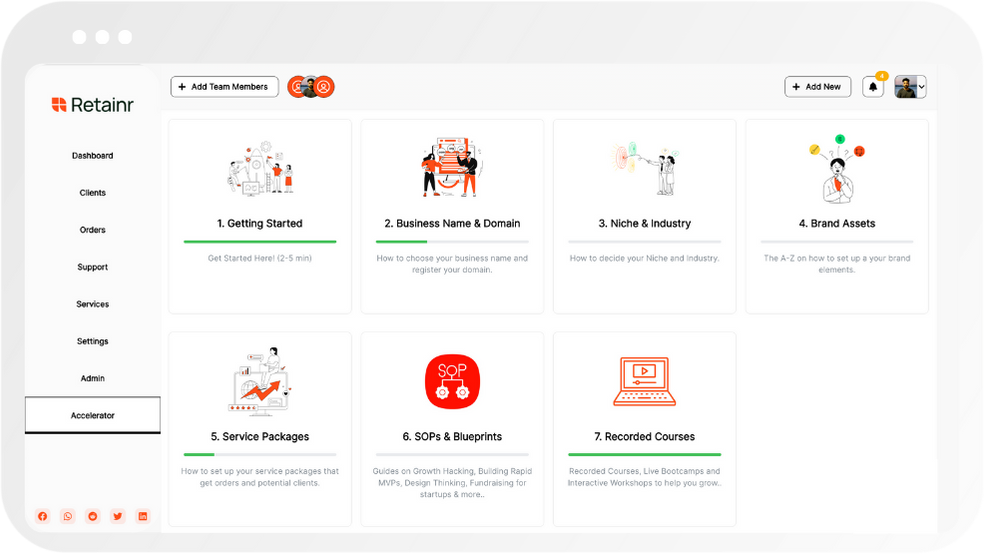
5 Steps For An Effective Process Workflow Automation
Build with Retainr
Sell your products and services, manage clients, orders, payments, automate your client onboarding and management with your own branded web application.
Get Started1. What are the five steps for an effective process workflow automation?
Breaking Down the Five Steps
When it comes to achieving an effective process workflow automation, it can be broken down into five critical steps. These steps include:
- Process Evaluation and Mapping
- Process Improvement
- Automation Software Selection
- Testing and Implementing the Automated Process
- Maintenance and Continuous Improvement
Detailed Explanation of Each Step
Each step is crucial to ensuring the effective automation of your process workflow. Firstly, Process Evaluation and Mapping involves identifying current processes that would benefit from automation, noting their inefficiencies. Secondly, Process Improvement involves using the insights from the evaluation stage to optimize these processes.
Thirdly, Automation Software Selection involves researching the variety of tools available, and choosing the one that best fulfills the automation needs you have identified. Fourthly, Testing and Implementing the Automated Process means trialing the new automated process on a small scale, making any necessary alterations, and then fully implementing it.
The final step, Maintenance and Continuous Improvement, sees continuous reviews and improvements, ensuring the automated process remains efficient.
Summary in Table Format
| Step No. | Step Name | Description |
|---|---|---|
| 1 | Process Evaluation and Mapping | Identify inefficiencies in current processes that could benefit from automation. |
| 2 | Process Improvement | Improve these processes based on insights from the evaluation stage. |
| 3 | Automation Software Selection | Research and select the tool that best suits your automation needs. |
| 4 | Testing and Implementing the Automated Process | Trial the new process on a small scale, fine tune it, then fully implement it. |
| 5 | Maintenance and Continuous Improvement | Ensure the automated process stays efficient through ongoing reviews and improvement updates. |
2. How can automation enhance an existing process workflow?
Benefits of Automation in Process Workflow
Automation can significantly enhance an existing process workflow. It can streamline operations, minimize the possibility of human error, optimize resource utilization, free up employees' time for more valuable tasks, ensure standardized operating procedures, and provide real-time visibility into processes.
- Streamlines Operations: Automation eliminates unnecessary tasks, simplifies complex workflows, and ensures smooth process flow, increasing the efficiency and productivity of the business.
- Minimizes Human Error: Automated systems are less prone to errors caused by human oversight or misunderstanding. This not only increases accuracy and consistency but also reduces the time and resources spent on correcting mistakes.
- Optimizes Resource Utilization: By automating routine tasks, resources can be redistributed to more critical aspects of the business, leading to optimized resource utilization.
- Frees Up Employees' Time: When tedious, repetitive tasks are automated, employees have more time to focus on strategic, creative, and customer-facing tasks, which can increase employee satisfaction and productivity.
- Ensures Standardized Operating Procedures: Automation ensures that every process is executed in the same way each time, promoting standardization and improving quality control.
- Provides Real-time Visibility into Processes: Automation tools often include comprehensive reporting and monitoring capabilities, allowing management to gain real-time insights, quickly identify bottlenecks, and make informed decisions.
How Automation Enhances Workflow: A Comparison
To illustrate the effect of automation on workflow processes, let's compare a manual and automated process workflow.
| Criteria | Manual Process | Automated Process |
|---|---|---|
| Efficiency | Limited by human capacity. | Greatly increased by automation. |
| Error Rate | More prone to human error. | Significantly reduced. |
| Consistency | Subject to variation due to human factors. | High, with standardization of processes. |
| Monitoring and Reporting | Manual reporting and tracking can be cumbersome and time-consuming. | Real-time tracking and reporting for informed decision-making. |
3. How do I start the process of workflow automation?
Understand Your Current Workflow
The first step in automating your process workflow starts with understanding your existing process. This includes knowing all the critical steps, requirements, possible exceptions, and stakeholders involved. It’s important to pinpoint inefficiencies, repetitive tasks, and bottlenecks in the current workflow. A flowchart or process map can be valuable for capturing and visualizing your process. Through this, you can gather insights and determine which areas need automation.
Analyse and Set Objectives for Automation
The next phase involves analyzing your current process and setting clear, measurable goals for automation. Determine what you aim to achieve: how you plan to improve efficiency, reduce errors, or enhance communication. Ensure that you align these objectives with the overall company strategy. Consider the potential benefits and trade-offs of introducing automation into your workflow.
- Benefit: Increased efficiency
- Benefit: Reduced errors and increased accuracy
- Benefit: Improved communication and collaboration
- Trade-off: Initial investment required
- Trade-off: Employee retraining
- Trade-off: Adjusting to new processes
Choose and Implement the Right Workflow Automation Tool
Selecting an appropriate workflow automation tool is crucial. With a multitude of options available, it is advisable to pick one that fits your business needs and growth objectives. Important factors to consider include ease of use, scalability, integration capabilities, cost, and customer support. Once you've selected your tool, start small. Implement it on one or two processes, gather feedback, make necessary adjustments, and implement it gradually throughout the organization.
| Factors | Questions to Ask |
|---|---|
| Ease of Use | Is the tool user-friendly? Can your employees learn to use it quickly? |
| Scalability | Can the tool handle an increase in workload as your company grows? |
| Integration Capabilities | Does the tool integrate well with your existing systems and software? |
| Cost | Does the cost of the tool align with your budget? |
| Customer Support | Does the tool provider offer adequate customer support? |
4. Could you explain the role of analysis in effective process workflow automation?
The Role of Analysis in Effective Process Workflow Automation
Analysis plays a significant role in the successful implementation of process workflow automation. It is a step that can't be overlooked as it forms the foundation for automation. Mainly, analysis aids in optimizing the execution of tasks, enhancing decision-making processes, and reducing functional errors within automated workflows. This is achieved through three fundamental processes.
- Initial Analysis: The first critical stage of analysis involves mapping out the existing workflow and processes. This gives a comprehensive insight into all relevant tasks and helps identify areas that can be streamlined or automated. Besides, it is during this phase that you can determine the issues within the current workflow.
- Requirement Analysis: After mapping out the existing workflow, the next stage is to define the requirements for automation. This encompasses detailing the software, hardware, and human resources necessary for effective implementation. Directives for compliance acceptance and certification are also established at this point.
- Data Analysis: Data analysis is crucial in the monitoring and evaluation of automation systems. By reviewing workflows regularly, you can identify any inefficiencies or errors and take timely action. This can ultimately help improve accuracy, speed, and efficiency of the automated processes.
| Stage of Analysis | Role |
|---|---|
| Initial Analysis | Helps map out existing workflow and identify issues |
| Requirement Analysis | Defines the requirements necessary for automation |
| Data Analysis | Helps in monitoring and evaluation of automation systems |
Thus, analysis is a pivotal part of process workflow automation, offering valuable insights throughout the automation process. From comprehending the initial status of the workflow to setting up automation requirements and understanding how to measure the effectiveness of automated systems, the role of analysis can't be overstated.
5. What is the importance of defining goals while automating a process workflow?
Setting Goals in Workflow Automation
The primary reason why businesses automate their processes is to boost efficiency and elevate productivity levels. Defining clear and tangible goals before setting up the automation workflow can largely determine the success or failure of the system. Here are key reasons why goal setting is critical:
- Efficiency: Clear goals help to streamline the automation process. This allows businesses to save on resources such as time and cost while increasing output.
- Measurement: Goals provide a benchmark for measuring progress and evaluating the effectiveness of the workflow automation.
- Clarity: With specific goals, employees can understand the entire process better, which increases acceptance and commitment to the workflow automation.
Goals in Different Areas of Workflow Automation
Depending on the business, goals for automating a process workflow may differ. Some common areas where goals are commonly defined include:
| Area | Sample Goals |
|---|---|
| Customer service | Decrease response time, Improve customer satisfaction |
| Sales | Increase lead conversion, Efficient sales funnel movement |
| Product Development | Speed up production time, Increase innovation |
| Finance | Improve budgeting process, Increase revenue |
The Process of Defining Goals
To effectively define goals in process workflow automation, a systematic approach must be adhered to. Here is a recommended method using the SMART (Specific, Measurable, Achievable, Relevant, and Time-bound) goal setting principle:
- Determine the specific areas in your process that need optimisation.
- Identify key performance indicators (KPIs) which would be used to measure the success of the automation.
- Ensure the goals are attainable and realistic based on current resources and capabilities.
- Goal alignment—ensure the automation goals align with the overall business objectives.
- Finally, set a clear timeline within which these goals should be achieved.
6. How to select the right tools and technology for process workflow automation?
Selecting the Right Tools and Technology
Choosing the correct tools and technology is a significant part of designing an effective process workflow automation. Because the market is saturated with a wide variety of tools and platforms, it is possible to become overwhelmed with options. Therefore, a careful and deliberate approach should be taken to ensure the selection of the most suitable tool based on the specific needs of the business.
Here are five steps to help you select the right tools and technologies:
- Identify your needs: Understand what you want to achieve with automation. This could range from reducing human error, streamlining tasks, improving productivity etc.
- Research: Conduct thorough research on the available technologies. Look at reviews, their pros and cons, and how they have been used by other similar businesses.
- Analyze Features: Compare the features of each tool. Ensure it is in alignment with your business processes and needs.
- Evaluate cost: Consider the cost of the tool. It should be within the company’s budget and offer good return on investment in terms of improved efficiency and productivity.
- Implementation and support: The chosen tool should be easy to integrate with the existing systems and the provider should offer good customer support.
| Tool | Features | Cost | Support |
|---|---|---|---|
| Tool 1 | Feature A, Feature B, Feature C | $$$ | Excellent |
| Tool 2 | Feature D, Feature E, Feature F | $$ | Good |
| Tool 3 | Feature G, Feature H, Feature I | $ | Fair |
This table can be used as a template to compare and choose among different tools and technologies. It will help to make an informed decision that will facilitate successful process workflow automation. Remember, there isn't a one-size-fits-all solution. The choice of tool largely depends on the specific needs, processes and objectives of your business. Also, ease of use, versatility and adaptability should be considered to ensure it can be used effectively by all users within the company.
7. What kind of training is required for employees in the implementation phase of workflow automation?
Understanding the Training Requirements
Implementing process workflow automation requires employees to possess the necessary skills and knowledge to handle the new technology successfully. Therefore, providing the right kind of training is integral to the implementation phase. Employee training can be broadly divided into three types.
- On-the-job Training: In this form of learning, employees learn by doing. They understand the new technology or workflow as they handle it in real-time. Occasional guidance from superiors or experts enhances their learning process.
- Off-the-job Training: Here, the employees are trained outside the actual work environment but in a simulated one. Tutors, e-learning modules, or seminars are the modes of teaching. Employees are allowed to make errors and learn without affecting the regular workflow.
- Mentoring: This is a one-to-one form of training where an experienced employee or 'the mentor' guides the mentee. The mentor imparts knowledge as well as provides emotional and professional support.
Deciding the Training Method
Different organizations may choose different training programs depending on various factors like size of the organization, nature of the job, the complexity of the new workflow, employee caliber, and budgetary constraints. The decision to select the training method should be made after a thorough analysis. An example comparative table is provided below.
| Training Method | Pros | Cons |
|---|---|---|
| On-the-job Training | Immediate hands-on experience, Realistic learning environment | Risky as mistakes can affect actual workflow, depends on the supervisor's teaching skills |
| Off-the-job Training | Error-free learning, Controlled training environment, Access to professional tutors | May not offer real-life work challenges, Can be costlier |
| Mentoring | Personalized coaching, Enhanced emotional support | Depends on the mentor’s teaching skills, Time-consuming |
Importance of Frequent Assessments
In any training program, it's imperative to keep assessing the knowledge and skill level of the employees periodically. This helps gauge the effectiveness of the training program and take corrective measures if necessary. Quizzes, simulations, and real-time problem-solving exercises can be utilized for this assessment process.
8. How to track and measure the success of an automated workflow process?
1. Identify Key Metrics
Before you can begin tracking the success of an automated workflow process, you must first identify the key metrics to be measured. This might include productivity, time savings, cost savings, error rates, process adherence and customer satisfaction. These metrics should be aligned with your business goals and specific objectives of the automated workflow.
- Productivity: Measures how much work gets completed in a set period.
- Time savings: Measures the decrease in time spent on a task due to automation.
- Cost savings: Measures the reduction in operational costs as a result of the automated workflow.
- Error rates: Keep track of the number of errors and mistakes reduced due to automation.
- Process adherence: Measures the compliance to established workflow procedures.
- Customer satisfaction: Evaluates how well client or customer needs are met.
2. Utilize Workflow Analytics Tools
After identifying the key metrics, the next step is to choose the right analytical tools to track these metrics. These can often be found within the automation software itself or through standalone analytics solutions. The chosen tool should be able to provide detailed reports, real-time updates, and visual dashboards for easy interpretation of data.
| Tool Features | Brief Description |
|---|---|
| Detailed Reports | Full data on all aspects of the automation process. |
| Real-time Updates | Live status updates on all workflows. |
| Visual Dashboards | Graphical presentation of data for better understanding. |
3. Conduct Regular Evaluations
Finally, it is important to evaluate the workflow system regularly to ensure its efficiency. This might include weekly or monthly performance reviews, conducting user surveys to gather qualitative data, and performing additional training for users if needed. Regular evaluations help to identify any possible issues and improvements that can be made to the automated workflow.
- Performance Reviews: Review key metrics to identify trends and opportunities for improvement.
- User Surveys: Gain insights from the actual users of the automated workflow.
- Training: Ensure all users are competent and confident in using the automated system.
9. Why is it necessary to continuously review and improve a process workflow automation?
The Necessity of Regular Review and Improvement for Workflow Automation
Regularly reviewing and improving automated workflow processes is a vital practice, essential to maintain efficiency and competitiveness in any business model. There are three main reasons for the importance of this activity, which we will discuss in further detail.
- Updating the Technology: Technology in business is never static and is constantly evolving. Software tools that were initially deployed might go through regular updates, or even be replaced by more efficient ones. Neglecting to review and update the technological tools used in workflow automation could lead to decreased productivity.
- Process Improvement: Over time, the workflow process initially automated might require modifications due to changes in business strategy, market dynamics, or because new process improvement opportunities were discovered. Continuous review is essential to identify such areas of improvement and implement these changes.
- Spotting Errors and Inefficiencies: No system is flawless, and an automated process is no different. Regular checks are essential to identify possible errors and inefficiencies, which could cause setbacks if left unnoticed. Regular reviews ensure these mistakes are promptly corrected, and the automated process remains streamlined.
| Activity | Importance |
| Updating the Technology | Ensure the latest, most efficient tools are being used. |
| Process Improvement | Make necessary modifications due to changes in business strategy. |
| Spotting Errors and Inefficiencies | Identify and correct possible setbacks in the automated process. |
In conclusion, for an automated process workflow to consistently deliver its intended benefits of enhanced efficiency and productivity, it must be regularly reviewed and improved. This allows its adaptability to changes in technology and helps spot and rectify potential errors or inefficiencies.
10. What challenges may arise during implementing effective process workflow automation and how can they be overcome?
Challenges in Implementing Effective Process Workflow Automation
Various challenges may arise during the implementation of an effective process workflow automation system. Some of these challenges include resistance from employees, technical difficulties, lack of clarity regarding end goals, and poor communication. Let's look at these in more detail.
- Resistance from Employees: Employees often resist changes, especially those that threaten their job security. Overcoming this challenge requires clear communication about the benefits of automation. It's also crucial to provide adequate training for workers to feel comfortable with the new tools.
- Technical Difficulties: Implementing new technologies can be challenging. Infrastructure may need to be updated, which can be time-consuming and costly. To overcome this, it is advisable to work with experienced professionals who understand how to seamlessly integrate new systems.
- Lack of Clarity Regarding End Goals: It is important to have a clear vision of what the business hopes to achieve. Shared, realistic goals ensure that all team members are working towards the same objectives.
- Poor Communication: Effective communication is key when implementing new systems. Open dialogue encourages feedback and solutions to help overcome any issues during implementation.
Overcoming the Challenges
The following table outlines some potential remedies for these implementation challenges.
| Challenge | Potential Solution |
|---|---|
| Resistance from Employees | Clear communication, providing adequate training, and showing empathy. |
| Technical Difficulties | Hiring experienced professionals, updating infrastructure, and providing ongoing technical support. |
| Lack of Clarity Regarding End Goals | Establishing clear, shared, and realistic automation objectives for the entire team. |
| Poor Communication | Promoting open dialogue and creating a feedback-friendly environment. |
Conclusion
Step 1: Identify repeatable and recurring processes
Identify processes that occur frequently, have a high-volume, and have a similar repeat pattern in your business. These tasks are the best fits for automation.
Step 2: Process Analysis
Evaluate the identified processes in terms of time consumption, resource requirement, and output quality. Also, identify any bottlenecks or inconsistencies.
Step 3: Workflow Design
Layout a new workflow process that leverages automation to address bottlenecks and inefficiencies identified in the previous step. Standardize this design to make it repeatable.
Step 4: Choose your Workflow Automation Tool
Select an automation tool that best fits your business needs and resources. We recommend Retainr.io, a whitelabel software that allows you to sell, manage clients, orders, and payments with your own branded app.
Step 5: Implement, Test, and Review
Implement the new process, conduct a test run to identify any gaps, and review performance regularly.
The benefits of process workflow automation are immense, saving you time, resources, and reducing human errors. Retainr.io can help you unlock these advantages through their highly customizable software. Start on your path to enhanced efficiency with Retainr.io today!
Boost Your Agency Growth
with Retainr Accelerator
Uncover secrets, strategies, and exclusive blueprints to take your agency's growth to the next level — from marketing insights to effective presentations and leveraging technology.

SOPs, Cheatsheets & Blueprints
Leverage 50+ SOPs (valued over $10K) offering practical guides, scripts, tools, hacks, templates, and cheat sheets to fast-track your startup's growth.
Connect with fellow entrepreneurs, share experiences, and get expert insights within our exclusive Facebook community.
.jpg)

Join a thriving community of growth hackers. Network, collaborate, and learn from like-minded entrepreneurs on a lifelong journey to success.

Gain expertise with recorded Courses, Live Bootcamps and interactive Workshops on topics like growth hacking, copywriting, no-code funnel building, performance marketing and more, taught by seasoned coaches & industry experts.

.jpg)

.jpeg)


